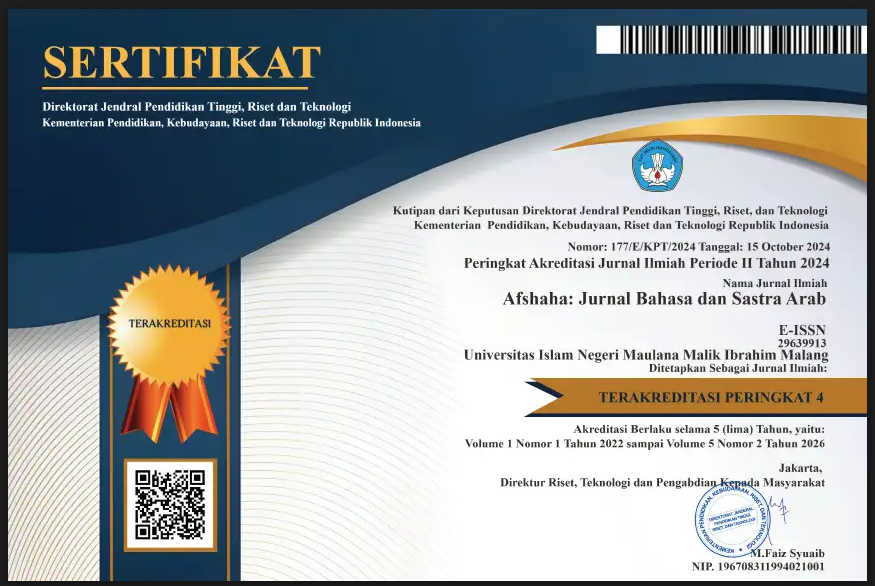AL-SHIRA’ AL-SIYAASIY FI RIWAAYAT AL-KARNAK LI NAJIB MAHFUZ WIFQA NADHARIYYAT RALF DAHRENDORF
Abstract
This study aims to describe the phenomenon of politic conflict experienced by the characters in the novel al Karnak by Najib Mahfudz. Therefore, the researcher uses Ralf Dahrendorf's theory of political conflict to identify social conflicts in the novel. This study uses a qualitative method with a literature study model. Then the researcher used reading and note-taking techniques to obtain data related to social conflict in al Karnak's novel. Reading technique aims to identify politic conflict events in al Karnak's novel. While the note-taking technique aims to facilitate researchers in the process of coding for each event. After the data was obtained, data analysis was carried out using the Miles, Hubarman and Saldana model. Namely, data collection, data reduction, data presentation and drawing conclusions. The results showed that each character in the novel al Karnak wishes for a revolution in Egypt. This means that there is a strong desire to change the ideology of the state. The government, on the other hand, rejected the revolution. According to Ralf Dahrendorf's conflict theory, the government is the dominant group, while society is the dominant group. So that the government group has authority over the people
Full Text:
PDFReferences
Agustina, S. Y., Wargadinata, W., Maturedy, F., & Maimunah, I. (2020). Syi’ru Al-Jazal Al-Magribiy f ī Ḍaw’ Ad-Dirāsat At-Taqābuliyyah Baina Al ‘Arabiyyah Al-Fusha wa Al-‘Āmiyyat Al-Magribiyyah. Lughawiyyāt: Jurnal Pendidikan Bahasa Dan Sastra Arab, 3(2), 210–224. https://doi.org/https://doi.org/10.38073/lughawiyyat.v3i2.520 Angin, T. B. B. (2021). Analisis Gaya Bahasa dalam Novel Perempuan Mencari Tuhankarya Dianing Widya Yudhistira. Jurnal Education and Development, 9(1), 533. http://journal.ipts.ac.id/index.php/ED/article/view/2411 Edfanda, M., Ainusyamsi, F. Y., & Hidayat, D. (2021). Ragam Anxietas Masyarakat Mesir pada 1960-an. Hijai – Journal on Arabic Language and Literature, 4(1), 16–17. https://doi.org/https://doi.org/10.15575/hijai.v4i1.10381 Hafidzulloh, M. S. M., & Salam, A. (2021). Al-Karnak by Najib Mahfudz : Anatomy of Sovereignty , Inequalities , and Dilemmas of Humanity. International Symposium on Religious Literature and Heritage (ISLAGE), 644(Islage 2021), 107–114. Jumadin, Z., & Wibisono, Y. (2020). Konflik Politik Antara Gubernur dan DPRD DKI Jakarta dalam Proses Penetapan APBD 2015. Jurnal Sosial Dan Humaniora, 4(8), 249–303. https://doi.org/10.47313/ppl.v4i8.698 Kaharudin, N. (2021). Dari Nuktah Menuju Nobel Sastra: Menyimak Najib Mahfuz Berkisah. Dekonstruksi, 5(01), 94–105. https://doi.org/10.54154/dekonstruksi.v5i01.77 Khoiriyah, A., Wargadinata, W., & Maturedy, F. (2021). Tashwir Mujtama’ Mishra fi Majmuah al Qashidah “al Diwan al Awwal” li Hisyam al Jakh inda Nadzariyah Alan Swingewood. JaLi: Journal of Arabic Literature, 2(2), 109–120. https://doi.org/https://doi.org/10.18860/jali.v2i2.12467 Lestari, Y. S. (2018). Politik Identitas Di Indonesia: Antara Nasionalisme Dan Agama. Journal of Politics and Policy, 1(1), 19–30. https://jppol.ub.ac.id/index.php/jppol/article/view/4 Mahfudz, N. (2015). ِAl Karnak (4th ed.). Daar Shoirouk. Meiliyanti, Y. T., Setiyono, J., & Supriyadhie, K. (2019). Kajian Hukum Humaniter Internasional Mengenai Cyber Warfare dalam Konflik Bersenjata Internasional antara Israel dan Palestina atas Gaza. Diponegoro Law Journal, 8(2), 1581–1600. https://ejournal3.undip.ac.id/index.php/dlr/article/view/25485 Muttaqin, M. Z. (2018). Ideologi: Faktor Konflik dan Kegagalan Timur Tengah. Nation State Journal of International Studies, 1(2), 207–219. https://doi.org/10.24076/nsjis.2018v1i2.134 Novianti, H. (2019). Kritik Sosial dalam Novel “Tak Sempurna” Karya Fahd Djibran Tinjauan Sosiologi Sastra. Inovasi Pendidikan: Jurnal Pendidikan, 6(1), 1–9. https://doi.org/https://doi.org/10.31869/ip.v6i1.1567 Nugroho, A., & Yasafiq, Y. (2019). Perbandingan Nilai Sosial dalam Novel Ivanna Van Dijk dengan Novel Ananta Prahadi Karya Risa Saraswati melalui Pendekatan Sosiologi Sastra. Silampari Bisa: Jurnal Penelitian Pendidikan Bahasa Indonesia, Daerah, Dan Asing, 2(1), 29–43. https://doi.org/10.31540/silamparibisa.v2i1.271 Putri, T. S., Yulianeta, & Agustiningsing, D. D. (2021). Nilai-Nilai Sosial dalam Novel Si Anak Badai Karya Tere Liye dan Pemanfaatannya sebagai Bahan Ajar Apresiasi Sastra Siswa SMA. @rtikulasi, 1(1), 65–74. https://ejournal.upi.edu/index.php/JPBSI/article/view/32529/14023 Rosianti, M., Widayanti, M., & Sugiyanto, Y. (2019). Nilai Sosial dalam Novel “Ayah” Karya Andrea Hirata: Kajian Sosiologi Sastra. KLITIKA: Jurnal Pendidikan Bahasa Dan Sastra Indonesia, 1(2), 96–104. https://doi.org/10.32585/klitika.v1i2.475 Sari, H. (2021). Aliran Realisme dalam Karya Sastra Arab. Diwan : Jurnal Bahasa Dan Sastra Arab, 12(1), 1–14. http://journal.uin-alauddin.ac.id/index.php/diwan Sari, N. L., Agustina, E., & Lubis, B. (2019). Nilai-Nilai Sosial dalam Novel Tentang Kamu Karya Tere Liye Kajian Sosiologi Sastra. Jurnal Ilmiah Korpus, 3(1), 55–65. https://doi.org/https://doi.org/10.33369/jik.v3i1.7346 Sauri, S. (2019). Nilai-Nilai Sosial Dalam Novel Hujan Karya Tere Liye Sebagai Bahan Pembelajaran Kajian Prosa Pada Mahasiswa Program Studi Diksatrasiada Universitas Mathla’ul Anwar Banten. Konfiks: Jurnal Bahasa, Sastra Dan Pengajaran, 6(2), 1–8. https://doi.org/https://doi.org/10.26618/konfiks.v6i2.2687 Sriwahyuni, I., & Asri, Y. (2020). Kritik Sosial Dalam Novel Nayla Karya Djenar Maesa Ayu. Pendidikan Bahasa Indonesia, 9(1), 90. https://doi.org/10.24036/108268-019883 Sugiyono. (2017). Metode Penelitian Pendidikan (Pendekatan Kuantitatif, Kualitatif dan R&D). Suhandra, I. R. (2019). Hubungan Bahasa, Sastra, Dan Ideologi. Cordova Journal : Language and Culture Studies, 9(2), 172–182. https://doi.org/10.20414/cordova.v9i2.1613 Suminar, E. R., Karman, & Solihin, I. (2019). Simbol Masalah Sosial dalam Novel Al-Karnak Karya Najib Mahfudz (Kajian Semiotika Charles Sanders Pierce). Hijai – Journal on Arabic Language and Literature, 02(2), 30–40. https://doi.org/https://doi.org/10.15575/hijai.v2i2.5515
DOI: https://doi.org/10.18860/afshaha.v1i1.16017
Refbacks
- There are currently no refbacks.
Copyright (c) 2022 Afshaha
Member of:
Indexed by:
Editorial Office
Faculty of Humanities, Universitas Islam Negeri Maulana Malik Ibrahim Malang
Jalan Gajayana 50 Malang, Jawa Timur, Indonesia 65144
Phone (+62) 341 551354, Facsimile (+62) 341 572533
e-mail: afshaha@uin-malang.ac.id

Afshaha: Jurnal Bahasa dan Sastra Arab by Faculty of Humanities Universitas Islam Negeri Maulana Malik Ibrahim Malang is licensed under a Creative Commons Attribution-ShareAlike 4.0 International License.
Afshaha: Jurnal Bahasa dan Sastra Arab, e-ISSN: 2963-9913










